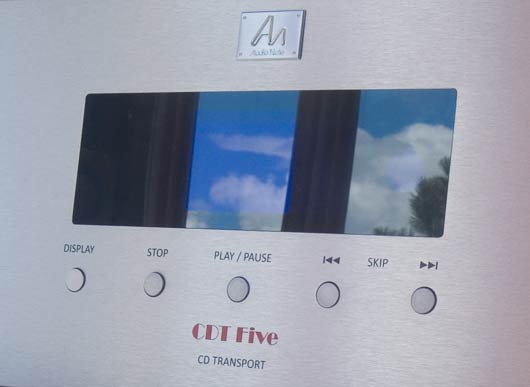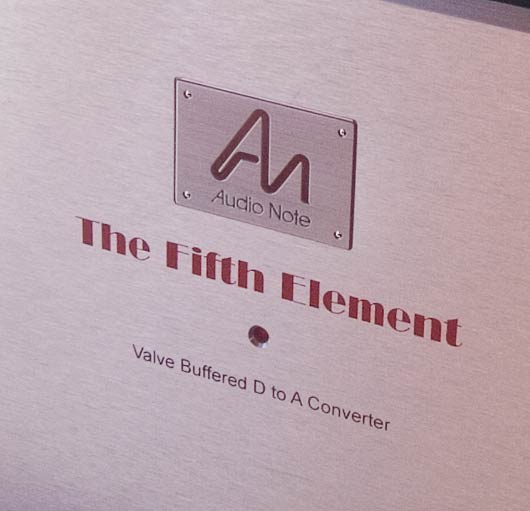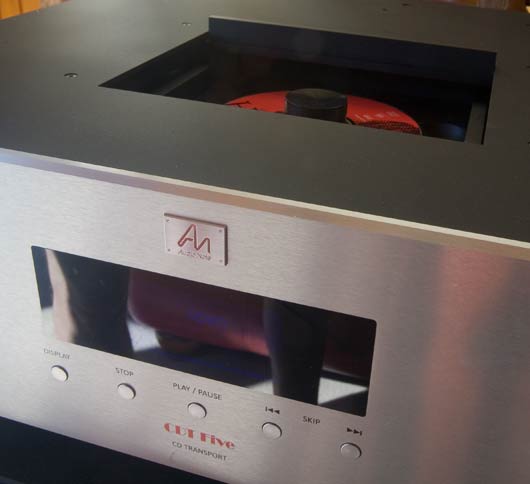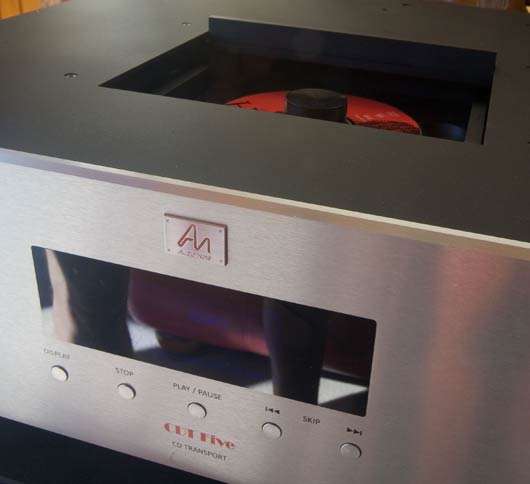This $185K (2011 pricing), 3-box (CDT-Five Transport, Fifth Element DAC and its Fifth Force power supply) digital front end is somewhat difficult to describe and put into context except to say that it is so clearly better in so many. many ways than what has been previously available – it is hard to imagine even those audiophiles with preferences out there on the very fringe not easily, EASILY preferring this player over other players and most turntables.

But, OK. Some details…
It is expensive. OK. Got that out of the way. 
It is also unquestionably significantly better than other playback, and by so a large a margin, that it is easy for one to fall into this “Why would I ever want to play anything else?” attitude and just stop thinking about what it is doing. You stop thinking in terms of “Oh, I wish we had an LP version of this CD” and start focusing on the music [and finding out where it has hidden itself in your collection if your collection is as unorganized as ours is :-)]
This playback is better in all the areas, if we are going to slice and dice it, that audiophiles might feel are important: if you are a detail head, this playback has so much more resolution that it restores your faith in science [more on this later]. If you are a harmonics-head, … oh boy. If you are a sound-stage head, or imaging-head, or dynamics head [later, later]… everybody who focuses on their must-have attributes – they will be ecstatic because they are all there to the max, glorious in all their splendiferousness.
[later] This may be hard to explain to people who are not familiar with what LPs do so well compared to CDs… but let’s try. CDs are supposed to have a larger dynamic range than LPs, but this seemed true only when one compared the softest possible note that these media can manage with their loudest possible note. But with ordinary notes, CDs have always sounded compressed. Dull. Not as lively as an LP. I have always thought ‘more dynamic range’ was essentially marketing BS. But… with the CDT-5/Fifth Element, the difference in dynamics between CD and good LP playback is so small, I do not know now which has more dynamics [it is close enough, I am not sure I care all that much to see which ‘wins by a nose’ here].

(the Fifth Element DAC. The metal appears slightly red because the nearby sunlight is reflecting off our bright red leather couch)
Let’s compare this stack to the Emm Labs XDS1. No we are not eating our young here, we love love love the XDS1, but I think it might help to compare the Audio Note to this very different sounding player that we have so much respect for here at Audio Federation. Although the XDS1 is only $25K (i.e. one EIGHTH the price) it is significantly better than all other solid-state players no matter their price and no matter your sonic preferences [Of course, the same can be said for their little $11,500 CDSA player as well, but let’s not go there…].
It might be instructive to revisit the ways in which the XDS1 excels as a CD/SACD player. First, it has an amazing ability to render the various threads in a musical score without jumbling them all up – not just great separation of notes, but of separation of sequences of notes, various harmonics and of the instruments themselves.
Second it has an extremely black black background. When a note decays you can hear it… hear it… still hearing it… until it ends or the recording engineer turns the volume down to zero. This also allow us to hear very very fine subtle notes and note characteristics. This might be considered another side to ‘high resolution’ – allowing us to actually hear the resolution that is there as opposed to artificially shining a light on the note attacks in various regions of the midrange as is so common amongst the competition.
Finally [skipping to the end here…] the XDS1 just sounds less digital and more like music. I always find this amazing, when comparing this player in shootouts. The other players do not ‘sound digital’ until one hears the XDS1… and then it is “OMG, how did I not hear this problem before?”
OK.
Back to Audio Note’s Fifth Element DAC and CDT-5 Transport.
This is a tube-based solution and therefore you might think it has its natural advantages and disadvantages.
BZZZZZZZZZZzzzzzzzzzt! Wrong.
Well. You are right but…
…just not as right as you think you are 
The Audio Note digital source really excels in the areas where solid-state usually reigns supreme [love that word], it has higher resolution, better separation and Alllllmost as black a background in our shootouts [and, uh, maybe even a blacker background than the XDS1 – note-to-self we really have to move around some power cords to make this a little more fair].
In other areas it has [very very close!] the midi-dynamics of a good LP playback, it has a tonal truth that I have not heard ANYWHERE else [enough to make you cry when you realize just how poor our usual playback harmonics have been in this regard for the last 100 years]…. You can just add lots of etc.s here – but these are just some of the characteristics, the punching-me-in-the-face differences, of this digital solution compared with all others.
So…
It is 8 times as expensive as the XDS1… and 99% of all other players [many of which really, really suck – why do people buy this stuff? ]…
Is it 8 times as good?
It is this question, me trying to figure out what “8 times as good” means, that has taken me all these many weeks to understand [I could have written the above review in the first 10 minutes or so of hearing the Fifth Element/CDT-5].
One could approach this in this manner: The Fifth Element/CDT-5 is to the XDS1 as the XDS1 is to the…. well, I am not all that familiar with $3125 CD players. One could look at a used Audio Aero Capitole [$4K? a steal] or used Emm Labs CDSA [$5500K how do other solid-state CD player manufacturers stay in business…] or …
So, yeah. 8 times better.
One could also approach this as in “Where is the best place for me to spend $200K in my system?”

Well, it depends on your system and budget… and really, if you play CDs and want your CDs to sound their best and you just want to KNOW they sound their best and you don’t want to waste your life not listening to the best [which pretty much DOES describe myself, when I have the funds… (oh, and Neli? *sheesh*, she is more gung ho than me half the time)]

(the CD is IsoMike’s release of the Fry Street Quartet playing Haydn)
For the first time since Audio Federation started I started bringing out old OLD CDs. Old Cocteau Twins. Old Patrick O’Hearn, Old Pink Floyd live concert bootlegs [you never seen 3 people more hypnotized by the music – ever have a hard time blinking? – as we listened to an old version of Echos. Magic? Drug-like? How about Warp Drive-like]. Old Jefferson Airplane…
Let’s use Surrealistic Pillow as an example. A gold CD from 1985 or so. Sounds horrible. Seriously, seriously mucked up, man. Especially the complicated electric guitar sections – bright, confused, over-saturated, noisy, you name it. On the CDT-5/Fifth Element you could hear exactly how bad it is – but it wasn’t painful and there wasn’t any problem with listening to the whole CD. This digital playback is really good at stitching together the stuff it finds on CDs and making notes and stringing them together into music. This makes it sound nothing like a ‘digital sound’ with good CDs and makes bad CDs also not sound like digital, but instead like just good, but very badly recorded, music.
Typically, bad CDs are very painful to listen to because their badness, often very aggressive digital-sounding notes, is too hard for most players to handle – and those that can handle it, it is because they just dull and smooth the notes down to round blobs… which of course they also do to all kinds of music played, good or bad. But the CDT-5/Fifth Element does not sacrifice resolution or detail – instead one might say it is the over abundance of resolution, and perhaps especially harmonic resolution, that allows us to have our cake and eat it too i..e very well recorded music has all the detail you will ever be able to hear and bad music is actually listenable and to some extent enjoyable [limited in this case by our knowledge that we should be able to find a better recording of this if we could just get our lazy butts off of the couch :-)]
OK. Kind of a longish review. I won’t bore people with the “equipment has to go back, hate to see it leave, wish we could afford it” end-of-review cliche.
Instead, I will mention a way we use to make us psychologically come to terms with this eventually having to go back to the continent [it is AN’s show digital]. We could just not play music for a couple of weeks – and let the memory dim. We could throw a tantrum and stomp our feet [Oh, I so much want to do THIS!]. We could close Audio Federation, sell a lot of demo stuff off the floor, and just order them up.
But, another perspective is… we now know what the best digital is. No question. And there is nobody else really trying to make the best digital [though they are good at making the most EXPENSIVE this or that out there, and, with the press, the most hyped]. So we put it on The List, we look at the budget, and when we can afford it we will get it back. The hardest part – the analysis and getting to the actual buying decision, is done. And meanwhile we can enjoy other digital, hearing some issues they may have but that is OK. The CDT-5 transport, Fifth Element DAC and Fifth Force power supply are on our (capital ‘L’) List, don’t you know?…
i.e. …They’ll Be Back.
[thanks Jim, I think I stole this perspective from you(?)]







